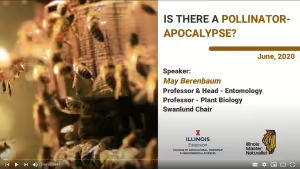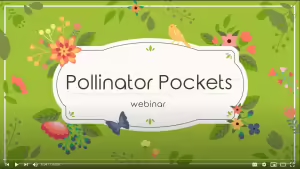Pollinator Pockets
Pollinator Pockets
Do your part to save the pollinators - the bees, butterflies, moths, and other insects critical to our food supply and human survival.
Plant a "pocket" of flowers that attract and nurture pollinators in your yard. The pollinator pockets described on this site will make it easy to select, plant, and maintain.
You may not realize that manicured lawns, exotic plantings, enticing hybrids, and cultivars often provide no value to pollinators. Placing pollinator pockets into your landscape provides an oasis for pollinators. Now that's sweet!
- Check out our pollinator pocket brochure.
- See our Pollinator Pocket map to marvel at all the habitats YOU have created!
Pollinator and Native Plant Videos
Imagine your dining table without the delectable fruits of apples, blueberries, cherries, peaches, or the versatile pumpkin or zucchini. Pollinators are also crucial, directly or indirectly, for the production of dyes, medicines, and fibers such as cotton.
Pollinators also sustain plant communities by pollinating native plants that provide wildlife food, nesting, and shelter. Pollinators include butterflies, moths, beetles, hummingbirds, bats, flies and wasps. In North America, 99% of pollinators are insects, and most are bees.
Unfortunately, pollinators are in dangerous decline. Yet gardeners can be a positive influence on pollinator populations and diversity if we all do our part to plant pollinator-friendly gardens.
Here are a few of the basics for a pollinator-friendly garden.
Food for pollinators is generally provided by flower nectar and pollen; however, some pollinators, such as butterflies, need specific plants, such as milkweed, for monarchs to serve as food for caterpillars. Additional research must be conducted to determine their needs during each life stage to attract particular pollinators.
Good pollinator plants include asters, beebalm, native roses, Joe Pye weed, purple coneflower, great blue lobelia, white indigo, lead plant, blazing stars, beard tongue, bellflowers, hollyhocks, monkshood, snapdragons, sunflowers, foxglove, mints, tomatoes, butterfly weed, goldenrod, larkspur, milkweeds, herbs and many more bee-utiful flowers.
When possible, choose native plants and not cultivars of native plants. Ornamental changes within cultivated plants may not provide the necessary attributes of a good pollinator flower. Exotic plants such as butterfly bush can provide food for bees and butterflies but cannot sustain the complete life cycle of pollinator insects. In addition, native plants provide food for a greater diversity of pollinators.
Plant masses of similar flowers and design areas to have flowers blooming all season. Aim for a variety of flowers blooming at once. Add easy-to-grow annual seeds such as zinnia and sunflower to existing perennial flower gardens to support diversity.
Convert a section of your lawn to a “Pollinator Pocket,” a suggested planting plan developed by UI Extension educators, Master Gardeners, and Master Naturalists. Designs developed for an approximately 5-foot by 5-foot space include options for various sun, shade, and moisture conditions.
Allow spaces between masses of flowers to provide shelter from wind and cold. Leave dead stems over the winter to provide shelter and nesting areas.
Limit, or better yet, eliminate pesticide use. When using pesticides, check with your local UI Extension office for proper timing and the least toxic options.
When you purchase plants, ask the seller if the plants were treated with neonicotinoids, a class of chemicals known to impact bees negatively. Avoid plants exposed to neonicotinoids.
If you are worried about luring something into your garden that can sting, keep in mind bees are not bullies looking for a fight. A happy bee is like a gardener in a garden center, focused on each flower.
If you like photography and want to become involved in citizen scientist bee research and identification, become a BeeSpotter
The Xerces Society has Identification Guides for a variety of pollinators.
The USDA Forest Service site provides identification tips and fun facts about pollinators.
For identification of pollinators, consider these online tools:
Are you ready to do your part for the pollinators but unsure where to start? Use the designs below to create your own Pollinator Pocket.
The designs address a variety of sun and moisture conditions. They fit into a roughly 4' x 6' oval organized for viewing from all sides. The blooming periods were selected to provide an all-season color. These native plants are available from a variety of sources.
Sun-Mixed Native and Non-Native Medium Moisture - This design reflects a sunny environment with full to partial sun and a mixed moisture level.
Sun-Dry - This design reflects a sunny environment with full to partial sun and dry conditions.
Sun-Moist to Wet - This design reflects a sunny environment full to partial sun and wet conditions.
Shade-Medium Moisture - This design reflects a woodland environment with dappled shade and a mixed moisture level.
Sometimes, homeowners and site managers are cautious about establishing native plants at their properties. They mistakenly think that native means wild, unmanageable, or giant. However, many options with natives can meet the design goals for gardens, homeowners, and more significant properties.
Four small prairie plots are in place at the University of Illinois Pollinatarium at 606 W Windsor Rd, Urbana, IL, to demonstrate some planting options. The plots are in the field just west of the building, containing short, medium-height, and tall plants and one plot of tall grasses and mixed plants. Visitors can envision how classes of various sizes will look in their locations. For example, a city may find that a short planting is desirable in front of the library, and a tall one is ideal for the sunny side of the fire station.
Pollinators need plants that provide pollen and nectar throughout the growing season for species like honeybees and those that complete their nesting cycle in the spring or fall. The plants in each plot collectively bloom through the seasons.
Since individual insects need small amounts of food resources, even relatively small plots of a few square yards can provide a desirable resource. The small pollinator plots are not intimidating and can be weeded and watered as necessary with minimal effort. They also allow testing of the prairie concept before launching a larger project.
It is also possible to include native plants in gardens with ornamental flowers. For example, perennial prairie plants could be planted in the back of a bed, perhaps mixed with ornamentals. The front planting could contain the annual plants many cities and park districts replant each year or season. By combining the concepts, fewer annuals would need to be purchased.
The Pollinatarium plantings are part of a project funded by the U of I Student Sustainability Committee to promote native planting on campus. The designs used plants that were available late in the season. Many other species could be used in the individual plots if the plot provided suitable blooms throughout the growing season.
Check out the designs below.
Plot 1: Short Plants (1-2' tall) in an 8' x 18' bed
Plot 2: Medium Plants (2-4' tall) in an 8' x 18' bed
Plot 3: Tall Plants (4-8' tall) in a 10' x 18' bed
Plot 4: Tall and Medium Plants with Grasses (4-8' tall) in a 10'x18' bed
Helpful brochures from our friends at Illinois-Indiana Sea Grant: Find them all here!
- Pollinator Garden - Native Plants for Attracting Pollinators
- Illinois Native Plants for the Home Landscape
- Full Sun Rain Garden - A Native Planting Guide for Rain Garden Beds
- Woodland Garden - Native Illinois Plants for Shaded Gardens
- Wet Woodland Garden- Native Illinois Plants for Wet and Shaded Gardens
- Woodland Edges Garden - Native Illinois Plants for Partly Shaded Gardens
- Dry Woodland Garden - Native Illinois Plants for Dry or Shaded Gardens
- Native Spring Ephemerals: A Guide to Native Spring Ephemerals in the Home Garden
These reference books provide information on native gardens that support pollinators:
- "Bringing Nature Home: How You Can Sustain Wildlife with Native Plants, Updated and Expanded" by Douglas W. Tallamy
- "Pollinator Conservation Handbook: A Guide to Understanding, Protecting, and Providing Habitat for Native Pollinator Insects" by Matthew Shepherd and Stephen L. Buchmann
- "The Midwestern Native Garden: Native Alternatives to Nonnative Flowers and Plants, an Illustrated Guide" by Charlotte Adelman and Bernard L. Schwartz
- "Attracting Native Pollinators: The Xerces Society Guide, Protecting North America's Bees and Butterflies" by The Xerces Society and Dr. Marla Spivak
- "The Know Maintenance Perennial Garden" by Roy Diblik
These organizations and their associated websites focus on pollinators:
- For more information on constructing bee nests and about bee-friendly gardens, check out the fact sheets available from the Xerces Society.
- The Pollinator Partnership is the largest non-profit organization in the world dedicated exclusively to protecting and promoting pollinators and their ecosystems. Their planting guide for Illinois is a good reference.
- The North American Pollinator Protection Campaign
- The USDA Natural Resources Conservation Services provides information on cover crops that benefit pollinators.
Visit the University of Illinois Pollinatarium to learn even more about pollinators.



